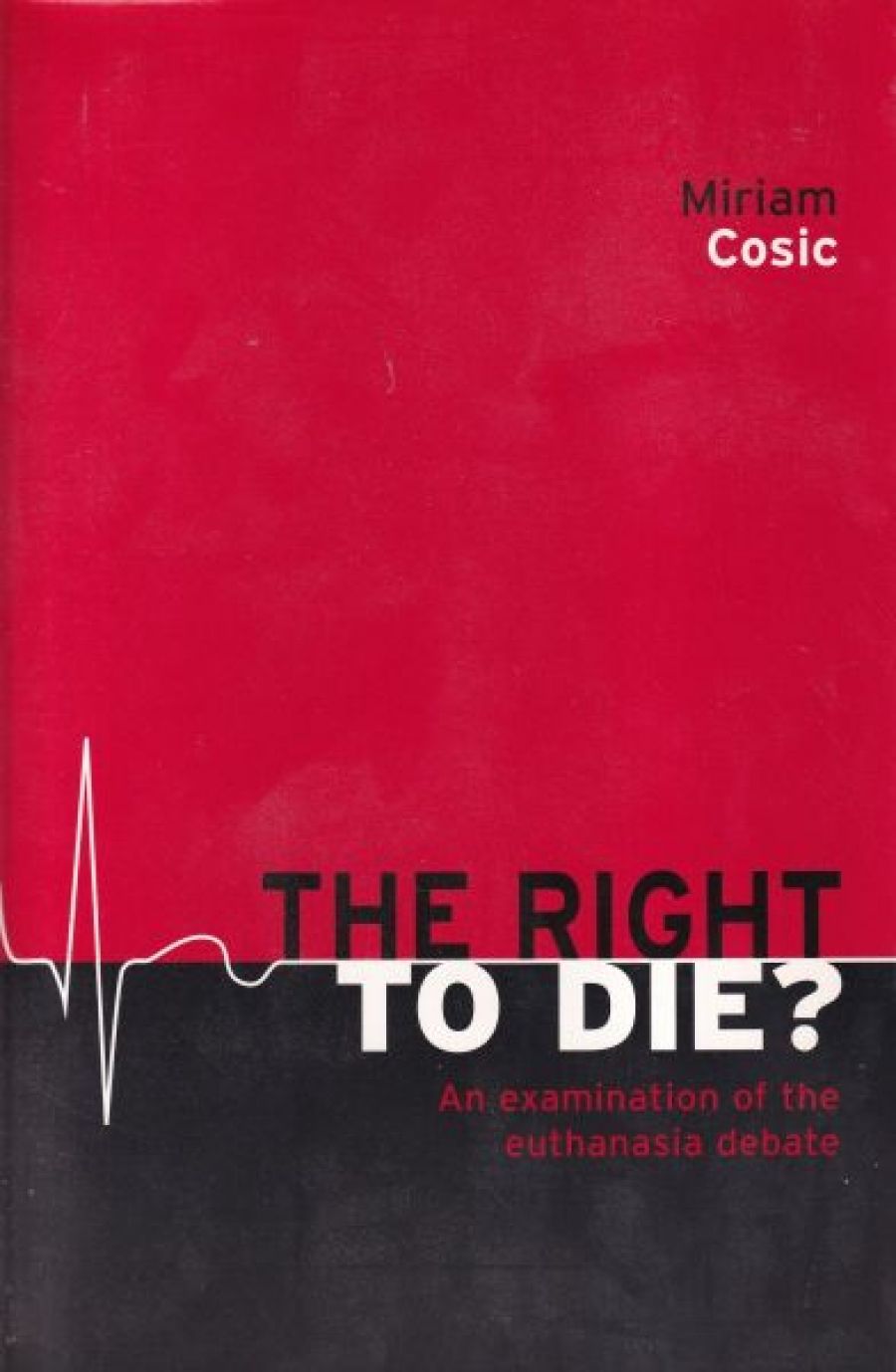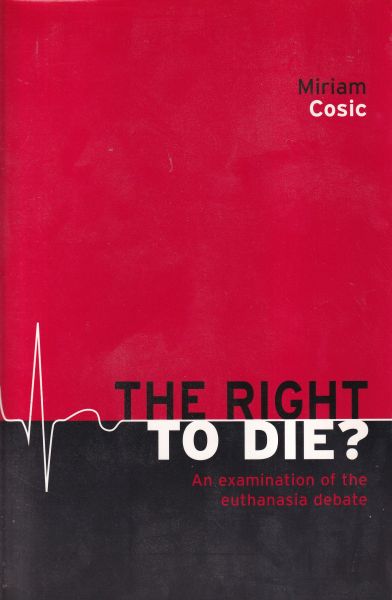
- Free Article: No
- Contents Category: Society
- Review Article: Yes
- Article Title: Consolations in a Void
- Online Only: No
- Custom Highlight Text:
In his ‘Letter to Menoecus’, the Stoic philosopher Epicurus famously argued that the notion of euthanasia is an oxymoron – death can be neither good nor bad for who dies. How could a complete void be rationally welcomed or feared? In her study of the ethical, legal and political issues raised by suicide and euthanasia, Miriam Cosic reveals how, to many, the concept of a good death is far from incoherent. Many people feel that the question of whether death can ever be a good thing is for them alone to answer.
- Book 1 Title: The Right to Die
- Book 1 Subtitle: An examination of the euthanasia debate
- Book 1 Biblio: New Holland, $24.95 pb, 295 pp
- Book 1 Cover Small (400 x 600):

- Book 1 Cover (800 x 1200):

Drawing on philosophical research and countless interviews with patients, families, health professionals and politicians confronting what decisions are to be made at the end of life, Cosic conveys very effectively the range and complexity of the issues. The euthanasia literature already features many books recounting moving and excruciating stories of the deaths of loved ones, and many academic textbooks reviewing the ethical and religious arguments for and against voluntary euthanasia. The Right to Die? successfully combines these two genres, locating the basic ethical concepts and principles in the reality of death and dying in a range of settings and countries. The book documents the cruel march of terminal illness and the agonising decisions that face patients, their bodies wasted by diseases.
There are also stories where euthanasia has been meticulously planned and has provided what patients have regarded as a fitting way to bring their lives to a close. For example, Dutchwoman Elisabeth Pop made a detailed contingency plan for how she wanted to die should she be struck down and rendered comatose by an accident. After witnessing the moving ceremony her mother had planned, her daughter said (of her own plans): ‘I am only 66 and very healthy. But in my experience … when everything is arranged, you feel at peace. Any day something might happen; you can have an accident and end up in a coma. But you can face that prospect peacefully when everything is arranged. That is the contradiction. You feel happier about dying, and so you can enjoy your life more. I don’t need to talk or even think about it anymore. I learned that from my mother.’
After outlining the relevant historical background and documenting the liberalisation of laws and attitudes to suicide and euthanasia in recent times, Cosic canvasses the main ethical and religious arguments for and against the practice and the legalisation of voluntary euthanasia. There is some discussion of the relevant philosophical distinctions, but these distinctions are not subjected to detailed philosophical scrutiny. Nevertheless, Cosic demonstrates how often these distinctions are invoked (both ingenuously and disingenuously) by health professionals in the decisions they make that help bring about a patient’s demise. The presentation and assessment of the arguments is clear and fair-minded, and usefully demonstrates some of their complexity to a broader audience.
Australia and the Netherlands have been at the fulcrum of the debate about euthanasia, so Cosic devotes a chapter each to the legislative developments in both countries. She chronicles the prelude to the Northern Territory’s Rights of the Terminally Ill Act (1995), which explicitly legalised voluntary euthanasia for the first time anywhere. The book evokes the drama of the knife-edge 13–12 vote in the Territory’s single-chamber parliament. The Rights of the Terminally Ill Act was overruled by federal legislation the following year, but the legislation in the Netherlands and, more recently, Belgium, have followed in its wake.
One highlight of the book is its discussion of the emotional impact of euthanasia on families, patients and doctors, which is often overlooked in bioethical discussions of the topic. Cosic also demonstrates how recognition of this impact need not undermine the view of access to euthanasia as a moral and legal right. She describes how Australian voluntary euthanasia advocate Dr Philip Nitschke felt ‘unnerved’ by what he was doing with each of the four patients he helped to die under the Northern Territory Act, but how he still believes he did the right thing.
Of course, anyone advocating legalised voluntary euthanasia must contend with the slippery slope argument. Cosic shows how, without proper substantiating evidence, the slippery slope argument is a piece of rhetoric or ‘spin’. She quotes Dutch politician Andre Rouvoet: ‘“Slippery slope” is too often used to defend a position one isn’t sure of … If something is right, you can build in safeguards and not go beyond them … We wouldn’t have trains now if we used the “slippery slope argument”.’ Nevertheless, the argument appeals to a consideration that any liberal must consider – the possibility of harm to others. It would be irresponsible to advocate the legalisation of voluntary euthanasia without looking at the health care system and political situation of the country in question. As bioethicist Margaret Battin has emphasised, in an environment where voluntary euthanasia had been legalised, one would need to consider possible institutional abuses, professional abuses and interpersonal abuses (say by the patient’s family) of such a law, and how legislation could be framed so as to protect patients from these risks.
Cosic shows how everyone has a stake in this issue, not just committed advocates. A remarkable feature of the euthanasia debate is the way that supporters of voluntary euthanasia are drawn from across the political spectrum.
The Right to Die? is a well-informed and useful contribution to the public debate that Cosic describes so impressively. This study presents an effective rejoinder to Epicurus – individuals of perfectly sound mind sometimes find their suffering so tormenting, or their lives so empty, that even a complete void can be preferable to them.


Comments powered by CComment